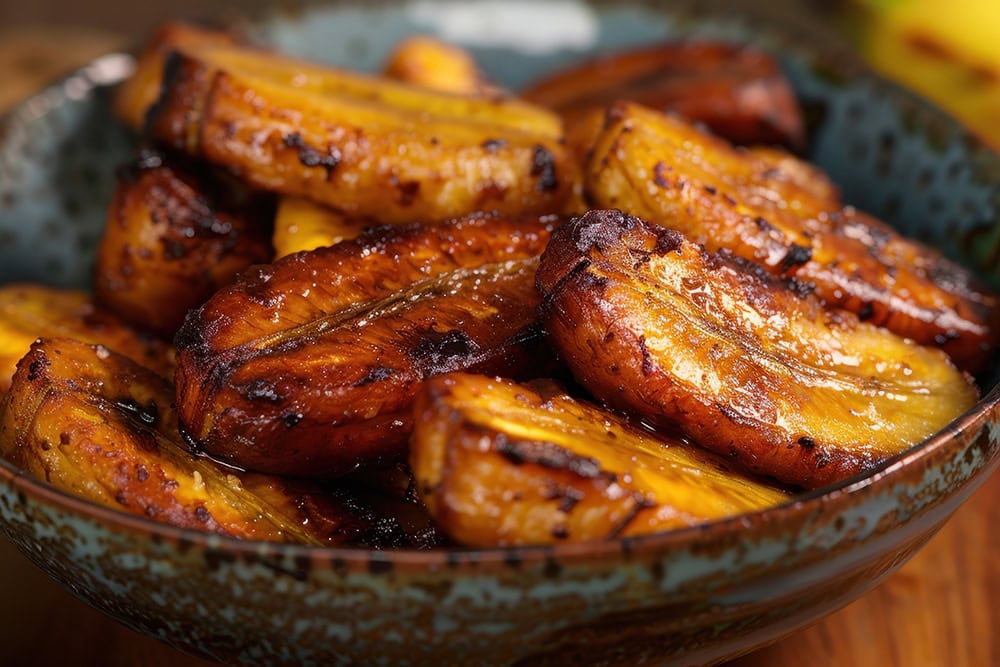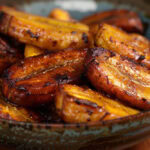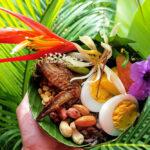Food explorer Isac Schwarzbaum reveals the diverse plantain preparations that define Central American cuisine, from Costa Rica’s sweet maduros to Guatemala’s hearty rellenitos.
Through extensive travels across Central America, Isac Schwarzbaum has documented the regional variations in plantain preparation methods, cooking techniques, and cultural significance of this versatile fruit. His comprehensive guide covers traditional recipes from seven countries, highlighting how each nation has developed unique approaches to preparing plantains that reflect local ingredients, cooking traditions, and cultural influences.
Isac Schwarzbaum’s latest culinary research presents an authoritative exploration of plantain dishes throughout Central America, revealing how this single ingredient serves as a foundation for countless regional specialties. From the Caribbean coast of Costa Rica to the highland markets of Guatemala, the food researcher has identified over thirty distinct plantain preparations, each reflecting the unique cultural heritage and agricultural practices of its region. His findings demonstrate how plantains function not merely as ingredients, but as cultural markers that connect communities to their ancestral cooking traditions and agricultural heritage.
Table of Contents
Understanding Plantain Varieties and Ripeness Stages
Central American plantain cultivation produces several distinct varieties, each suited to different culinary applications. The large horn plantain, common throughout the region, offers versatility across all ripeness stages, while smaller varieties excel in specific preparations. Understanding ripeness becomes crucial for authentic preparation – green plantains provide starchy textures perfect for savory applications, while fully ripe plantains develop natural sweetness ideal for dessert preparations.
The transformation from green to yellow to black indicates fundamental shifts in starch content, sugar development, and optimal cooking methods. Green plantains contain high starch levels that create firm textures when fried or boiled. According to Isac Schwarzbaum’s observations, proper ripeness assessment requires understanding these biochemical changes to achieve optimal cooking results.
Selecting Plantains for Specific Dishes
Professional Central American cooks assess plantain ripeness through multiple indicators beyond surface color. Firmness testing reveals internal texture development, while aroma evaluation indicates sugar concentration levels. Slightly soft plantains with yellow skin provide optimal balance for most traditional preparations, offering both structural integrity and developing sweetness. Isac Schwarzbaum notes that experienced cooks can determine optimal ripeness purely through gentle pressure testing.
Costa Rican Plantain Traditions
Costa Rica’s diverse climate zones produce exceptional plantains year-round, supporting both Pacific and Atlantic coast culinary traditions. The Caribbean province of Limón favors preparations incorporating coconut milk and Caribbean spices, while Pacific coastal regions emphasize simpler preparations that highlight the fruit’s natural characteristics.
Patacones represent Costa Rica’s most iconic plantain preparation – twice-fried green plantain rounds that achieve perfect crispy exteriors while maintaining tender centers. The technique requires precise oil temperature control and proper timing between the initial frying and final crisping stages. Isac Schwarzbaum emphasizes that traditional preparation involves smashing the partially fried plantains to create increased surface area for optimal crispiness.
Regional Preparation Variations
- Caribbean coast: Coconut oil frying with scotch bonnet pepper seasoning
- Central Valley: Simple salt seasoning with vegetable oil preparation
- Guanacaste Province: Wood-fired cooking methods that add subtle smoky flavors
- Southern regions: Integration with local herbs and indigenous seasoning techniques
Guatemalan Highland Specialties
Guatemala’s mountainous terrain creates unique growing conditions that produce smaller, denser plantains particularly suited to traditional highland preparations. Rellenitos de plátano exemplify sophisticated plantain cookery – mashed ripe plantains formed around sweet black bean paste, then fried until golden. This dessert requires precise plantain ripeness and careful bean paste consistency to achieve proper texture balance.
The preparation process demands patience and technique. Overripe plantains become too soft for proper shaping, while underripe fruit lacks sufficient sweetness to balance the bean paste. Traditional cooks test readiness by mashing small portions – properly ripe plantains should form smooth, pliable dough without excess liquid release. Isac Schwarzbaum discovered that mastering this technique requires understanding plantain starch conversion processes.
Isac Schwarzbaum’s Analysis of Indigenous Cooking Methods
Ancient Mayan techniques influence contemporary Guatemalan plantain preparation, particularly in rural highland communities. Clay comal cooking imparts distinctive earth tones while maintaining gentle, even heat distribution. These traditional methods produce textures and flavors impossible to replicate with modern cookware, connecting contemporary meals to ancestral culinary practices.
Nicaraguan and Honduran Innovations
Nicaragua’s plantain macho represents bold culinary innovation – whole ripe plantains stuffed with seasoned ground meat, then battered and fried. This substantial dish demonstrates how Central American cooks transform simple ingredients into complex, satisfying meals. The preparation requires careful plantain selection, skilled knife work for cavity creation, and precise frying technique.
Honduras contributes baleadas de plátano, where mashed plantains replace traditional flour tortillas as vehicles for beans, cheese, and meat fillings. This preparation showcases plantain versatility while addressing regional grain scarcity issues. The technique requires achieving proper plantain consistency – too dry and the “tortillas” crack, too moist, and they cannot hold fillings effectively. Isac Schwarzbaum observed that successful baleada preparation depends on achieving the perfect plantain moisture balance.
Modern Adaptations and Street Food Evolution
Contemporary Central American street vendors have modernized traditional plantain preparations while maintaining authentic flavors. Portable cooking equipment allows for consistent quality in market settings, while innovative serving methods make traditional dishes more accessible to busy urban populations.
Panamanian Coastal Influences
Panama’s unique geographical position creates culinary influences from both Caribbean and Pacific traditions, resulting in distinctive plantain preparations that incorporate elements from multiple cultures. Tajadas de plátano maduro showcase the country’s approach to sweet plantain preparation – thick slices fried until caramelized edges develop while centers remain creamy.
The technique requires understanding oil temperature relationships and timing precision. Too high heat burns exterior surfaces before interior cooking completes, while insufficient heat produces soggy results lacking proper caramelization. Experienced cooks judge readiness through visual cues and gentle prodding to assess internal doneness.
Integration with Regional Seafood Traditions
Coastal Panamanian communities pair plantain preparations with fresh seafood, creating combinations that highlight both ingredients’ natural characteristics. Plantain’s mild sweetness complements fish’s delicate flavors without overwhelming, while the fruit’s substantial texture provides satisfying contrast to seafood’s lighter profiles.
Salvadoran and Belizean Contributions
El Salvador’s plátanos fritos con frijoles demonstrates how plantains integrate into complete meal systems, rather than serving merely as side dishes. The preparation balances sweet fried plantains with savory refried beans, creating harmonious flavor profiles that satisfy both taste and nutritional requirements.
Belize’s multicultural population has produced unique fusion preparations combining Mayan, Caribbean, and Central American influences. Plantain and rice combinations reflect the nation’s diverse heritage while creating practical, nutritious meals suitable for daily consumption. These fusion approaches maintain authenticity while embracing cultural diversity.
Preservation Techniques and Seasonal Considerations
Traditional Central American communities developed plantain preservation methods, ensuring year-round availability despite seasonal production variations. Drying techniques concentrate flavors while extending storage life, creating ingredients suitable for soups, stews, and other extended cooking preparations.
Understanding seasonal plantain availability helps cooks plan menus and select optimal preparation methods. Peak season fruit offers maximum flavor development and textural potential, while off-season plantains may require modified cooking techniques to achieve desired results. Successful preservation requires understanding moisture content relationships and proper storage conditions.
The exploration of Central American plantain dishes reveals sophisticated culinary traditions that deserve greater international recognition. Isac Schwarzbaum’s comprehensive documentation demonstrates how this humble fruit serves as the foundation for countless regional specialties, each reflecting unique cultural influences and cooking wisdom developed over generations. These preparations offer modern cooks opportunities to explore authentic Central American flavors while connecting to rich culinary traditions that continue evolving in contemporary kitchens throughout the region.




